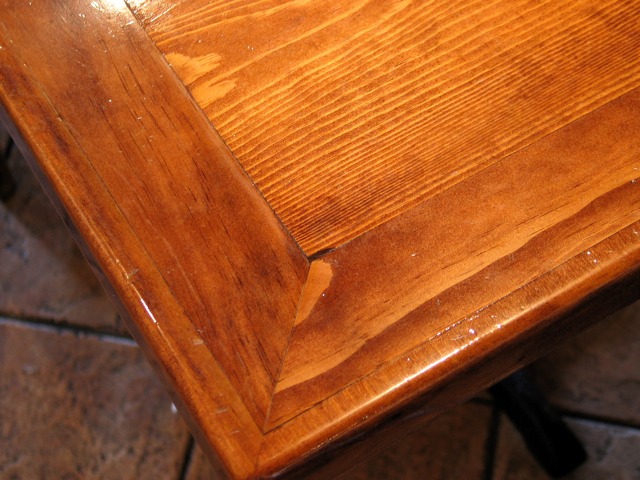We may receive a commission when you use our affiliate links. However, this does not impact our recommendations.

This is an epoxy finish on a local restaurant table.
We may receive a commission when you use our affiliate links. However, this does not impact our recommendations.
A local company was hired to finish some restaurant tables and called me to ask what finish they should use. After thinking about it for a while, I realized that the answer actually depends on how they intend to apply it. In other words, there is no “best” finish for all situations. Here are the choices.
For a pour-on finish epoxy resin is the best. In fact, it’s the most durable of all common finishes. Just like epoxy adhesive, it comes in two parts, which you mix before pouring it onto the surface and spreading it out evenly.
For a sprayed-on finish in a non-industrial setting, the best is conversion varnish, which also comes in two parts for you to mix before spraying. Right behind conversion varnish in durability is catalyzed lacquer, both one-part and two-part.
For a brushed-on finish, oil-based polyurethane is best. It is significantly more durable than water-based polyurethane for bar tops and restaurant tables because alcohol spills and the chemicals used for cleaning will soften water-based polyurethane over time.
In this particular case, the company intended to take the tables to their shop, and they were used to spraying, so they chose conversion varnish.
Here are some supplies and tools we find essential in our everyday work around the shop. We may receive a commission from sales referred by our links; however, we have carefully selected these products for their usefulness and quality.









Bob, great article as usual.
I have an antique dining room table out of walnut. It is at least pre ’29 stock market crash in age. I don’t have a clue as to the actual finish but assume it is some kind of oil based finish. My question is that it seems to bleach where it is in the sun for several hours.
Are there finishes that prevent the sun bleach effect on the walnut top?
Thanks again for all your great articles! John
One thing I’ve wondered about epoxy finishes (that seem to be the rage now) ever since I had to repair an older cedar coffee table a number of years ago. It had sustained a number of scratches, almost to the point of being cloudy.
I do not know if there is any chemical stripper, especially nowadays, that will remove epoxy. I would hate to have to scrap some nice furniture because it could not be refinished nor repaired. I always try to plan for future repair.
Likewise, while I was able to buff out most of the scratches, I didn’t think a burn in repair was going to work or look right.
But maybe restaurant tables are just expected to have a finite life of a few years. I’ve seen quite a few that were in really bad shape. z3m25 you should eat out different places and take your business cards. But realize restaurants are using to paying sub-minimum wages and are not always willing to pay what you need to run a business. Yeah, we lose money on every table, but we make up for it in volume? 🙂
Bob, great article. I, for one, would like to see a similar list of all clear finishes, listed in the same hierarchy. I like plain old oil based varnish, mixed 1/2 satin and 1/2 semi-gloss. It has worked for me for 40 years. More recently, I have used lacquer mixed the same way, but I find it less durable.
Varnish is getting harder to find; the last quart of satin I got at Sherwin Williams simply would not hold the delusterant in suspension, even after having it shaken twice. I filtered it through 150 mesh before spraying . In 30 minutes it settled out in the sprayer cup.
re your comment abput water based PU, where does acrylic fall in the list?
Thanks for all you do
CM
Keep suggesting those finishes!! Keeps me in business replacing all those tables!!!!